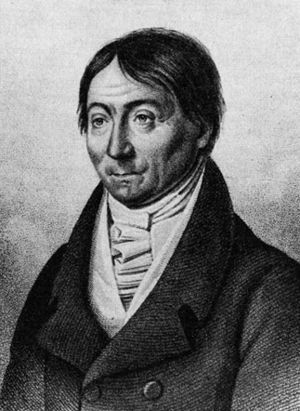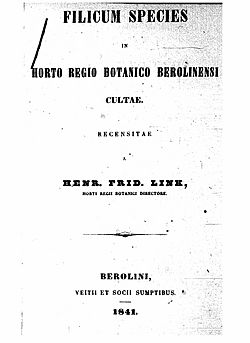Johann Heinrich Friedrich Link facts for kids
Quick facts for kids
Johann Heinrich Friedrich Link
|
|
|---|---|
 |
|
| Born | 2 February 1767 |
| Died | 1 January 1851 (aged 83) |
| Spouse(s) | Charlotte Juliane Josephi |
Johann Heinrich Friedrich Link (born February 2, 1767 – died January 1, 1851) was an important German naturalist and botanist. He studied many areas of science, but he is best known for his work with plants.
Contents
A Young Scientist's Journey
Johann Heinrich Friedrich Link was born in Hildesheim. His father, August Heinrich Link, was a minister who taught him to love nature. He encouraged young Johann to collect interesting natural objects.
Link went to the Hannoverschen Landesuniversität in Göttingen. There, he studied medicine and natural sciences. He earned his doctor's degree in 1789. His special project was about the plants growing on rocks around Göttingen. One of his teachers was the famous scientist Johann Friedrich Blumenbach. After graduating, Link became a private teacher in Göttingen.
Becoming a Professor
In 1792, Link became the first professor of a new department at the University of Rostock. This department covered chemistry, zoology, and botany.
While at Rostock, Link was an early supporter of new ideas in chemistry. He taught that oxygen existed, which was a new idea at the time. He also believed in using mathematics in chemistry, which helped create the study of stoichiometry (how much of each chemical is needed in a reaction). In 1806, he even set up the first chemistry lab at Rostock.
Link wrote many articles and books. His topics included physics, chemistry, geology, plants, animals, and even early history. He was chosen twice to be the head of the university, called the rector.
In 1793, he married Charlotte Juliane Josephi. She was the sister of one of his university colleagues.
Exploring Portugal and Growing Fame
From 1797 to 1799, Link traveled to Portugal. He went with Count Johann Centurius Hoffmannsegg, who was also a botanist. This trip helped Link decide that studying plants, or botany, was his main scientific passion.
In 1800, Link was chosen to join the famous Leopoldina Academy. This is the oldest school for natural history in Europe. His scientific reputation continued to grow. In 1808, he won an award from the Academy of Saint Petersburg for his book about the nature of light.
In 1811, Link became a professor of chemistry and botany at Breslau University. He was also chosen to be the rector there twice.
Leading the Berlin Botanical Garden
After another famous botanist, Carl Ludwig Willdenow, passed away in 1815, Link moved to Berlin. He became a professor of natural history, took care of the plant collection (herbarium), and became the director of the botanical garden. He stayed in this role until he died. This time in Berlin was the most successful part of his career.
He made the garden's collection much bigger, adding 14,000 different plants. Many of these were rare. He worked closely with Christoph Friedrich Otto, who also worked at the garden. In 1827, they named new types of cacti, like Echinocactus and Melocactus. Many of the fungi that Link named are still known by those names today. This shows how good his work was.
Link became a member of the Berlin Academy of Science and many other science groups. The Royal Swedish Academy of Sciences made him a foreign member in 1840.
He also taught many new scientists, like Christian Gottfried Ehrenberg. Link traveled a lot around Europe during his life. He was good at learning foreign languages, even Arabic and ancient Sanskrit.
Johann Heinrich Friedrich Link died in Berlin on January 1, 1851, when he was almost 84 years old.
Link is remembered as one of the last scientists of his time who knew a lot about many different subjects. He was also one of the few German botanists who tried to fully understand plants by studying their parts and how they worked.
His most important work was a three-volume book called Handbuch zur Erkennung der nutzbarsten und am häufigsten vorkommenden Gewächse. It was published between 1829 and 1833.
Important Works
Link wrote many books and articles. Here are a few examples of his important works:
- Grundlehren der Anatomie und Physiologie der Pflanzen (1807): This book was important because it showed for the first time that plant cells existed on their own. They were not just part of a big, mixed plant mass.
- Die Urwelt und das Altertum, erläutert durch die Naturkunde (1820–1822): This work explored prehistoric times and ancient history using natural science.
- Filicum species in horto regio Berolinensi cultae (1841): This book was about the different kinds of ferns grown in the royal botanical garden in Berlin.
- He also worked with Christoph Friedrich Otto on books like Icones plantarum selectarum horti regii botanici Berolinensis (1820–28), which showed illustrations of plants from the Berlin botanic garden.
- With Count von Hoffmansegg, he published Flore portugaise (1809–1840), a book about Portuguese plants that was a standard reference for a long time.


